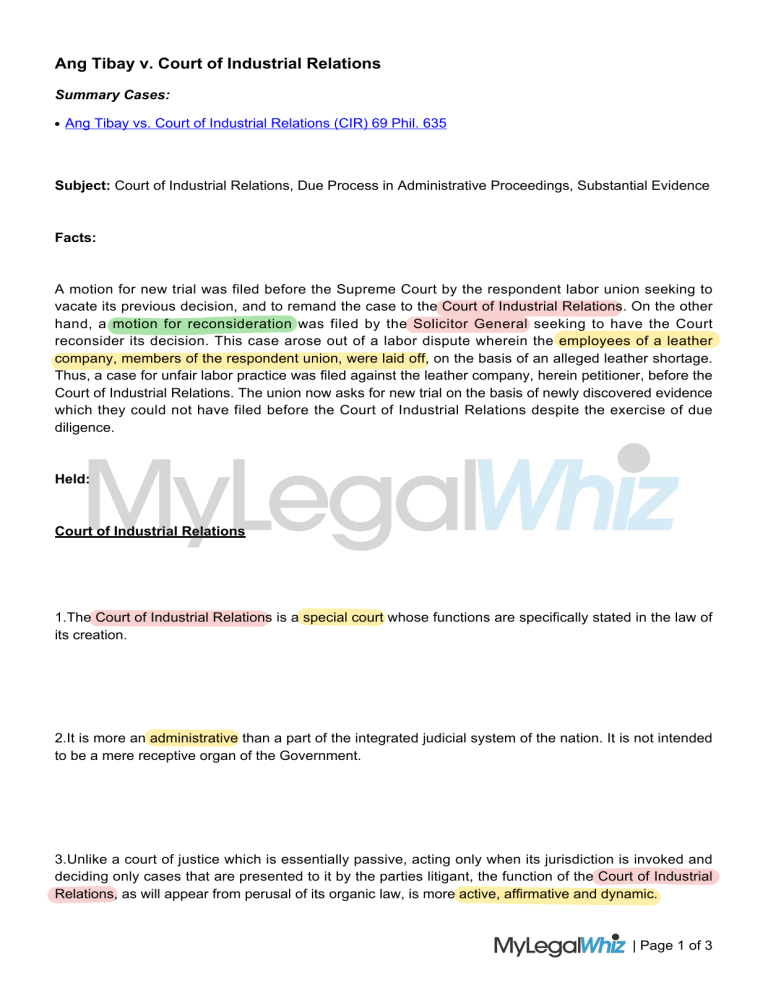
Ang Tibay v. Court of Industrial Relations Summary Cases: ● Ang Tibay vs. Court of Industrial Relations (CIR) 69 Phil. 635 Subject: Court of Industrial Relations, Due Process in Administrative Proceedings, Substantial Evidence Facts: A motion for new trial was filed before the Supreme Court by the respondent labor union seeking to vacate its previous decision, and to remand the case to the Court of Industrial Relations. On the other hand, a motion for reconsideration was filed by the Solicitor General seeking to have the Court reconsider its decision. This case arose out of a labor dispute wherein the employees of a leather company, members of the respondent union, were laid off, on the basis of an alleged leather shortage. Thus, a case for unfair labor practice was filed against the leather company, herein petitioner, before the Court of Industrial Relations. The union now asks for new trial on the basis of newly discovered evidence which they could not have filed before the Court of Industrial Relations despite the exercise of due diligence. Held: Court of Industrial Relations 1.The Court of Industrial Relations is a special court whose functions are specifically stated in the law of its creation. 2.It is more an administrative than a part of the integrated judicial system of the nation. It is not intended to be a mere receptive organ of the Government. 3.Unlike a court of justice which is essentially passive, acting only when its jurisdiction is invoked and deciding only cases that are presented to it by the parties litigant, the function of the Court of Industrial Relations, as will appear from perusal of its organic law, is more active, affirmative and dynamic. | Page 1 of 3 4. It not only exercises judicial or quasi-judicial functions in the determination of disputes between employers and employees but its functions in the determination of disputes between employers and employees but its functions are far more comprehensive and expensive. 5. In fine, it may appeal to voluntary arbitration in the settlement of industrial disputes; may employ mediation or conciliation for that purpose, or recur to the more effective system of official investigation and compulsory arbitration in order to determine specific controversies between labor and capital industry and in agriculture. There is in reality here a mingling of executive and judicial functions, which is a departure from the rigid doctrine of the separation of governmental powers. 6. The Court of Industrial Relations is not narrowly constrained by technical rules of procedure, and the Act requires it to "act according to justice and equity and substantial merits of the case, without regard to technicalities or legal forms and shall not be bound by any technicalities or legal forms and shall not be bound by any technical rules of legal evidence but may inform its mind in such manner as it may deem just and equitable." 7. The fact, however, that the Court of Industrial Relations may be said to be free from the rigidity of certain procedural requirements does not mean that it can, in justifiable cases before it, entirely ignore or disregard the fundamental and essential requirements of due process in trials and investigations of an administrative character. Due Process in Administrative Proceedings 8. There are primary rights which must be respected even in proceedings of this character: | Page 2 of 3 a. The first of these rights is the right to a hearing, which includes the right of the party interested or affected to present his own case and submit evidence in support thereof. b. Not only must the party be given an opportunity to present his case and to adduce evidence tending to establish the rights which he asserts but the tribunal must consider the evidence presented. c. While the duty to deliberate does not impose the obligation to decide right, it does imply a necessity which cannot be disregarded, namely, that of having something to support it is a nullity, a place when directly attached. d. Not only must there be some evidence to support a finding or conclusion but the evidence must be "substantial." e. The decision must be rendered on the evidence presented at the hearing, or at least contained in the record and disclosed to the parties affected. f. The Court of Industrial Relations or any of its judges, therefore, must act on its or his own independent consideration of the law and facts of the controversy, and not simply accept the views of a subordinate in arriving at a decision. It may be that the volume of work is such that it is literally Relations personally to decide all controversies coming before them. In the United States the difficulty is solved with the enactment of statutory authority authorizing examiners or other subordinates to render final decision, with the right to appeal to board or commission, but in our case there is no such statutory authority. g. The Court of Industrial Relations should, in all controversial questions, render its decision in such a manner that the parties to the proceeding can know the various issues involved, and the reasons for the decision rendered. Substantial Evidence 9. It means such relevant evidence as a reasonable mind accept as adequate to support a conclusion. | Page 3 of 3